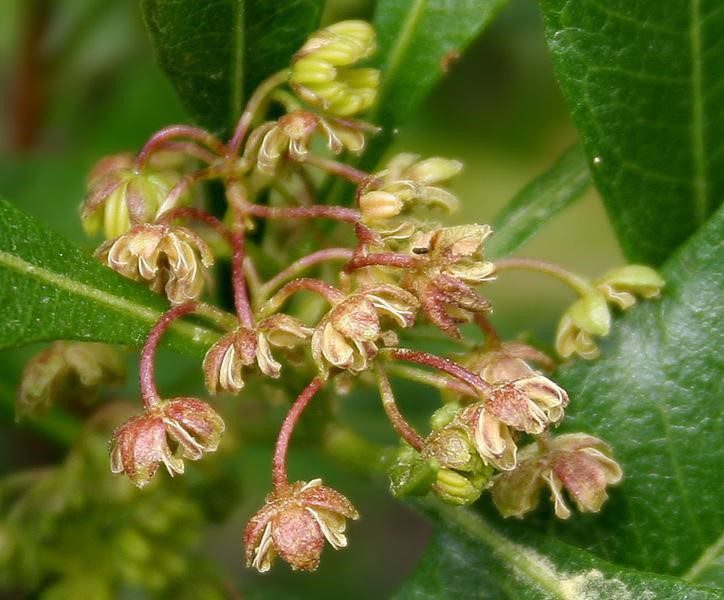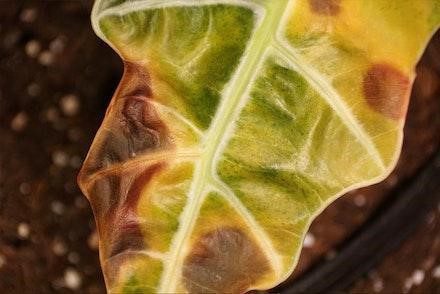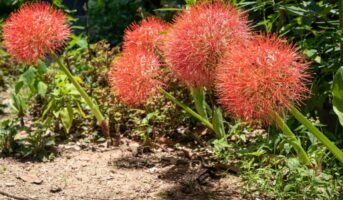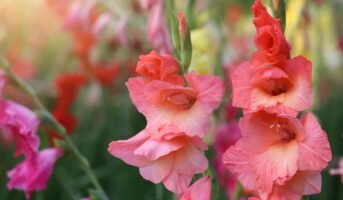The broadleaf hopbush, or Dodonaea viscosa, is a species of flowering plant in the Dodonaea (hopbush) genus widely distributed in tropical, subtropical, and mildly temperate regions of Africa, the Americas, southern Asia, and Australasia. The family of soapberries known as Sapindaceae includes Dodonaea.

Source : Wikepedia
This species is famous for having a vast range, which it only attained by marine spread over the last 2 million years (from its origin in Australia).
Dodonaea Viscosa: Common names
- The most common name for Dodonaea viscosa is hopbush.
- This plant is known as Virli in Tamil Nadu, a state in southern India.
- Common names for Dodonaea viscosa in Australia include soapwood, switch sorrel, wedge leaf hopbush, big hopbush, thin leaf hopbush, sticky hopbush, and native hop.
- In the Hawaiian language, more familiar names include “aalii”; Xayramad (Somalia), akeake (New Zealand), lampuaye (Guam), michelangelo (Palau), chirca (Uruguay, Argentina), romerillo (Sonora, Mexico), jarilla (southern Mexico), hayuelo (Colombia), ch’akatea (Bolivia), casol caacol (Seri), and ghoraskai (Afghanistan).
Dodonaea Viscosa uses: Health benefits and medicinal uses
- Dodonaea viscosa was traditionally used to treat rheumatism, skin infections, diarrhea, stomachaches, discomfort from the liver or spleen, uterine colic, and other problems involving smooth muscles.
- It was also used as an antipruritic for rashes, dermatitis, hemorrhoids, and sore throats. Rheumatism, gout, hemorrhoids, fractures, and snake bites were all treated with leaf infusions.
- When producing beer, bitter fruits of Dodonaea viscosa can be used in place of yeast and hops.
- Malaria is treated using Dodonaea viscosa seeds, blended with seeds from other plants, and coated in honey.
- The Dodonaea viscosa wood is solid and long-lasting. The Mori have historically used it to make weapons, carved walking sticks, axe handles, and weights on drill shafts in New Zealand, where it is the heaviest of all natural woods.
How to grow Dodonaea Viscosa?
- The flowers of the Dodonaea viscosa lack petals. These tiny than centimeter-wide blooms bloom in the spring and summer. The plants are dioecious, which means that the flowers can be either male or female and often grow on different plants.
- The wind spreads the pollen. However, the development of the capsules does not need fertilization. Therefore, unfertilized capsules mature faster than fertilized capsules, which might take up to 11 months to reach maturity.
- The capsules’ color will change from green or cream to vivid crimson during this period. Only female or bisexual flowers produce these winged capsules, which are around 2 cm in size.
- Both cuttings and seeds work well for growing Dodonaea viscosa. However, cuttings are frequently favored to ensure a female plant with vibrant capsules.
- The best cutting material is recently formed new growth. The ideal next step is to apply a rooting hormone. The medium can be either straight perlite or perlite mixed with peat or coconut fiber.
- If seeds are being used to propagate Dodonaea viscosa, soaking them in boiling water before planting will help them germinate.
- Dodonaea viscosa needs a bright place and enjoys well-drained soils. Therefore, although it can handle some shade, the color of the capsules will not be as vibrant.
- Dodonaea viscosa can withstand some frosts as well as dry circumstances. Little upkeep is required. However, consistent tip trimming will encourage branching and growth.
- Because of the fluid leaves, the scale may be a problem. However, an application of white oil is a successful treatment if this is the case.
Care instructions for Dodonaea Viscosa
The Best Way To Start Growing
The best way to grow Dodonaea viscosa is through seeds, vegetative reproduction, and small plantations.
Planting Season
Spring and summer are the best seasons for planting Dodonaea viscosa as the plant requires full sun for it to grow initially.
Pruning Season
Dodonaea viscosa is the perfect plant to use as a specimen, screen, or informal hedge. In the fall and winter, prune for structure; throughout the growth season, tolerate shearing.
Water Requirement
A quick-draining soil is an absolute necessity for Dodonaea viscosa. Depending on the ultimate desired size, different amounts of water are required. Larger size and an arborescent (tree-like) shape are caused by more water. Lack of water results in a tiny, rounded bush.
Light Conditions
Dodonaea viscosa enjoys warmer temperatures and thrives best in situations with full sun or slight shade. Flower beds support plants. They may either be pruned or trimmed into a hedge. Any soil, ocean breeze, and dry heat are tolerable.
Bloom Season
Blooming in Dodonaea viscosa occurs in February, April, and August, respectively.
Dodonaea Viscosa: Pests and diseases

Source:Wordpress.com
Dodonaea viscosa is vulnerable to the “Dodonaea yellows” virus. The name comes from the disease’s stunted yellow leaves. Witches’ brooms are a disorder that is also accompanied by distorted leaf edges and internodal extension of branches in twigs.
- On the damaged branches, flowering and fruiting may be diminished or missing altogether. Sometimes the virus affects the entire plant, and other times it only affects some branches.
- With this species, ants, scale, and sooty mold might occasionally be a concern. In addition, mealybugs and black twig borers can be an issue if not swiftly handled.
- Keep an eye out for dead twigs or branch tips and apply an insecticide containing imidacloprid, as necessary.
Dodonaea Viscosa: Yellowing of leaves

Source: datocms-assets.com
The yellowing of leaves of Dodonaea viscosa can be caused by any of the below reasons.
Watering
Regarding gardening and plant health, water is a complicated issue. First, consider your watering practices in frequency and volume if you see a yellowing of the leaves or branches of Dodonaea viscosa. Water that is either too much or too little can cause yellowing.
Nutrition
Beware of odd yellow patterns on leaves; they may clearly indicate nutritional problems. For instance, it is nearly always a symptom of malnutrition if the veins on the leaves of Dodonaea viscosa are green and the tissue is yellow. To prevent Dodonaea viscosa from receiving too much or too little fertilizer, adhere to the instructions on the container.
Sunburn
Dodonaea viscosa may also be turning yellow because, like people, plants may become sunburned. The midday sun may be extremely intense in summer. If at all feasible, provide some daytime shade or cover the leaves. Do not deny the plants any sunshine, though. The health of Dodonaea viscosa can significantly benefit from a well-placed shade cloth. To assist the plant escape midday or late afternoon sun, it is advised to place a shade cloth over it.
Importance of Dodonaea Viscosa according to Vastu and Feng Shui
- Dodonaea viscosa is thought to bring success, money, and health to a house.
- According to Feng Shui, Dodonaea viscosa may bring luck to the home by being positioned in the east, southeast, south, or north.
Is Dodonaea viscosa native to Australia?
Dodonaea viscosa is widely found across every state and territory in Australia. it is highly variable. There are seven sub-species. The seven sub-species of Dodonaea viscosa are D.
Is Dodonaea viscosa a shrub?
Dodonaea viscosa is a shrub, which grows up to a height of up to 3 metres. It also rarely found as a small tree, reaching a height of up to 9 metres.
Is Dodonaea viscosa fast growing?
Dodonaea viscosa is a shrub that is known to grow rapidly. Owing to its dense growth characteristics, it is used widely for hedging or informal screen.
How tall does Dodonaea viscosa grow?
The Dodonaea viscosa plant remains a shrub up to the size of 6 to 8 feet. It can attain a maximum height of 12 feet and a width of around 2 metres, through proper care and more water. Ensure regular pruning to promote its growth and bushy characteristics.
Bottom line
The plant Dodonaea viscosa is perfect for your garden or the outdoors. It is attractive, offers health advantages, is simple to maintain, grows more quickly, etc.
To add this tropical beauty to your backyard or outdoor space, you may buy seeds or a little Dodonaea viscosa plant from the nursery. So, embrace your inner gardener and plant Dodonaea viscosa, which will add to the beauty of your interior or outdoor spaces.
FAQs
Is it safe to consume Dodonaea Viscosa?
Unless used in massive amounts, Dodonaea viscosa is generally considered safe.
How to grow Dodonaea Viscosa indoors?
If cultivating inside, plant Dodonaea viscosa next to an East-facing window that will provide morning sun for most of the day and afternoon shade. You can also think about positioning a few feet away from a South-facing window for diffused light. Keep in mind that putting Dodonaea viscosa in direct sunlight from a South-facing window will stunt development and cause leaf scorching. A sheer curtain can be used to soften the glaring light coming in from a South-facing window.
What is the best time to grow Dodonaea Viscosa?
Spring and summer are the best times for planting Dodonaea Viscosa.
Is Dodonaea Viscosa toxic to pets?
Dodonaea Viscosa can be toxic to pets if ingested in huge quantities.
Is Dodonaea Viscosa allergic?
Dodonaea Viscosa may contain pollen which can cause allergic reactions in humans.
Housing News Desk is the news desk of leading online real estate portal, Housing.com. Housing News Desk focuses on a variety of topics such as real estate laws, taxes, current news, property trends, home loans, rentals, décor, green homes, home improvement, etc. The main objective of the news desk, is to cover the real estate sector from the perspective of providing information that is useful to the end-user.
Facebook: https://www.facebook.com/housing.com/
Twitter: https://twitter.com/Housing
Email: [email protected]











